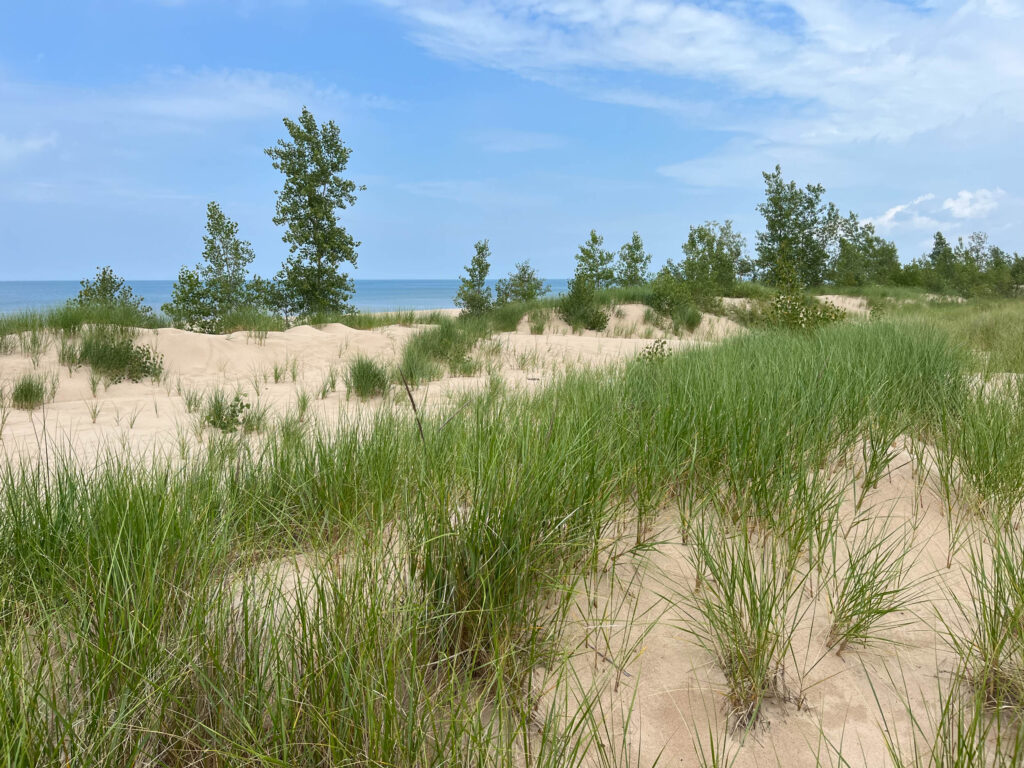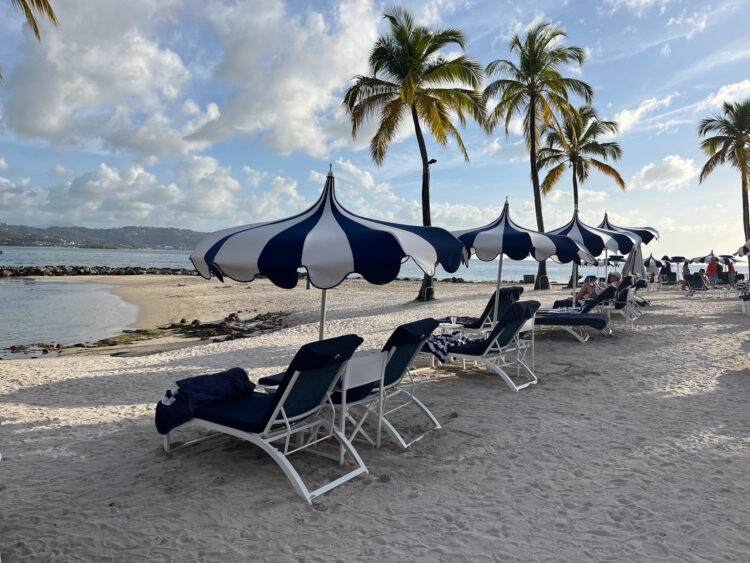Starting in the forests of Miller’s Woods, this lovely trail passes across a pond, through the forest savannah, before meandering through the sands dunes and ending at the beach of Lake Michigan. This trail passes through an area with incredible biodiversity and is our favorite hike in the Indiana Dunes National Park and is one of the best hikes in Indiana Dunes National Park.
Looking for more information for planning a visit to Indiana Dunes? Check out:

Quick Overview of the Paul H Douglas Trail
Distance: 3.4 miles Elevation Gain: minimal Difficulty: Easy/moderate
There are two options for this hike in Indiana Dunes National Park. You can do the 0.9 mile Millers Woods Trail or the longer out and back trail to the beach. If you have the time we recommend the longer trail as it truly offers that most variety.
The trail to the beach offers the most diversity and passes through multiple ecosystems.
The entire Paul H Douglas trail takes about 1.5 – 2 hours to complete.

Map of the Paul H Douglas Trail

Things to Know about the Paul H Douglas Trail
Parking for the Paul H Douglas Trail
To hike the Paul H Douglas Trail, park at the Paul H Douglas Center for Environmental Education. There are 2 parking lots here. The smaller lot right at the trailhead only has room for a few cars, while the larger parking lot across the street has more space.
This lot is at the end of N Lake Street.
Fee for the Trail
In order to visit Indiana Dunes National Park and hike the Paul H Douglas Trail, you will need a park pass. You can purchase a 1-7 day pass for Indiana Dunes, or use an America the Beautiful Annual Pass. You can see the most updated fees at the NPS site.
Dogs on the Trail
Dogs are allowed on the trail but must be leashed.
Best Time of Year to Hike the Paul H Douglas Trail
This trail can be hiked all year long, although the best time to hike the trail is in the spring or the fall. In the spring (May-July) you will find lovely wildflowers including lupine. Summers can be hot and humid. During the winter you can also ski the trail, specifically the Miller’s Woods part of the trail.
We hiked the trail on July 1 and we got to see the end of the spring wildflowers. We just missed seeing all the lupine in bloom. It was hot and humid during our hike so if you are planning to hike in the summer, earlier is better.
Paul H Douglas Trail Open Hours
The Paul H Douglas Trail is open sunrise to 30 minutes after sunset.
Hiking Details of the Paul H Douglas Hike
The trail starts right at the Paul H Douglas Center for Environmental Education on a flat and wide open trail. The trail passes over a series of bridges and boardwalks over the pond and through Miller’s Woods.
This is a great place to look for birds and beaver.
After crossing the bridge, the trail winds through the forest. There are several places where there are multiple trails going off the main trail, but the trail is generally easy to follow. After a short distance, you can make the decision to hike the short woods loop or head to the beach. There is a short rise where you can get views of the ponds.
The next part of the hike goes through a black oak savannah. This area is old sand dunes that now have plants and trees growing on them. Part of the trail is sandy, but it is generally an easy walk. This area has the most wildflowers of the hike.
There are very few black oak savannahs in the world, so this is a special part of the trail.

After about 1 mile, the trail becomes much more sandy and follows along the edge of some wetlands and ponds. The sand in this section was much deeper and more challengings to walk in. The trail also gets narrow in several sections around the last pond before opening up in the dunes just before the beach.

The trail passes just a short distance through the dunes before ending at the beach. This is one of the quieter and prettiest beaches in the park and even in mid-summer there were only a few other people on the beach. It is possible to swim in the water although it is very shallow for a while.
This is also a great place for a picnic.
After you enjoy yourself at the shoreline, retrace your steps back to the parking lot.


Tips for Hiking the Trail
Below are a few tips to keep in mind when hiking the Paul H Douglas Trail:
- Plan your visit and check trail conditions: Before setting out, make sure to check the trail conditions and park regulations. Trails can be affected by weather, closures, or construction. The park’s website or visitor center will have up-to-date information to help you plan accordingly.
- Dress appropriately and pack essentials: Wear comfortable hiking shoes or boots suitable for the terrain, as some sections of the trail may be sandy or uneven. Dress in layers to accommodate changing weather conditions, and carry extra clothing, sunscreen, insect repellent, a hat, and sunglasses. Don’t forget to bring water and snacks to keep yourself hydrated and energized during the hike.
- Follow the trail map. There is a map at the beginning of the hike and generally well marked trails. Familiarize yourself with the trail map and markers before embarking on your hike – understanding the trail layout will help you navigate the route more easily. Look out for trail markers and signs to stay on the designated path.
- Take your time and enjoy the scenery: The Paul H. Douglas Trail offers breathtaking views of Lake Michigan, dunes, wetlands, and forests. Take breaks along the way to soak in the natural beauty and capture memorable moments. Pace yourself and allow ample time to fully appreciate the sights and sounds of the trail. Binoculars are a great idea for this hike as there are many birds.
- Practice Leave No Trace principles: Indiana Dunes National Park is a protected area, and it’s essential to minimize your impact on the environment. Follow the Leave No Trace principles by staying on the marked trail, disposing of trash properly, and respecting wildlife and vegetation. Leave the trail as you found it, ensuring the natural beauty is preserved for future visitors.
Common Questions about the Paul H Douglas Trail
Is there anything unsafe on the trail?
This is generally a safe hiking trail although you will find lots of poison ivy along all the trails in the park. Use general hiking caution and be aware that cell service may be limited. Make sure you have enough water, especially during the hot summer months.
Is the Paul H Douglas Trail worth it?
Yes – this was our favorite hike in Indiana Dunes National Park
You Might Also Like
Looking for more on planning a National Parks trip? Check out our National Park Destination Guides or see exactly how we plan a National Parks Trip.
You can also find our favorite day hiking gear or see more about hiking in general





